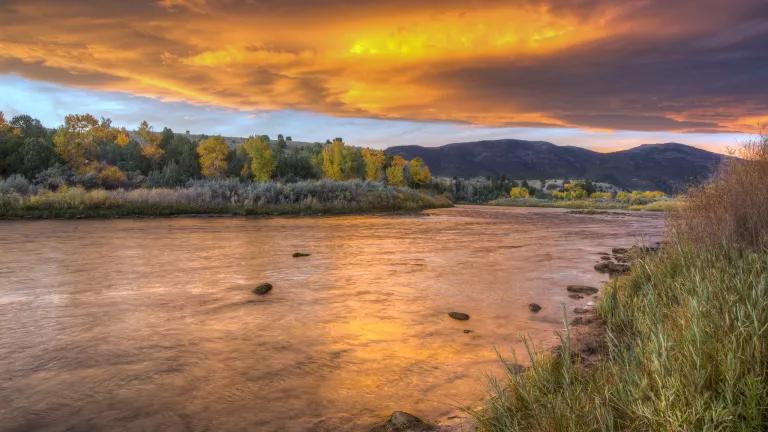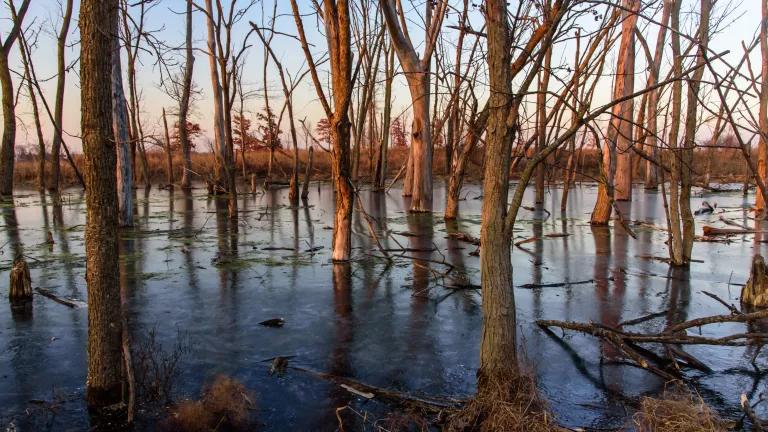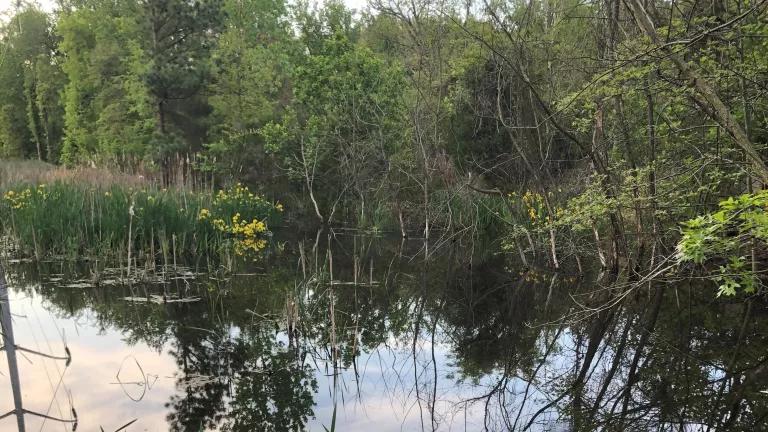Key Questions about a Potential "Grand Bargain" on CA Water
For several years, state and federal agencies, local water districts, and a few conservation groups have participated in negotiations regarding potential voluntary settlements on Delta flows. NRDC has not participated in those negotiations for two primary reasons. First, participants—including state and local governments—were required to sign confidentiality and/or nondisclosure agreements, and NRDC felt strongly that requiring such agreements as a condition of participation was of dubious legality and was contrary to good government. Second, we strongly believed that durable, scientifically credible settlement agreements are extremely unlikely to occur before the State Water Resources Control Board adopts new standards. Virtually all major settlement agreements in the history of California water occurred after courts or agencies adopted new protections for the environment, whether that’s the Yuba Accord, the settlement agreement to restore the upper San Joaquin River, or the Bay-Delta Accord.
The expectation seems to be that the Directors of DWR and CDFW will present an outline or framework of a so-called “Grand Bargain” to the State Water Resources Control Board on Wednesday. Since NRDC has not been privy to these secret negotiations, we do not know what the proposal will include. But below are key questions for the Board and public to consider when evaluating any proposals from the President Trump's and Governor Brown’s administrations.
1. What Else is in this So-Called Grand Bargain?
As noted above, we expect that the State will propose new flows that the State Water Resources Control Board could consider as part of its update of the Bay-Delta Water Quality Control Plan. However, that’s not the only thing that the agencies are negotiating in secret. The Metropolitan Water District of Southern California publicly reported at their September 2018 Board meeting that the negotiations cover four issues that could be part of an “interrelated agreement”: (1) the Coordinated Operating Agreement (COA), which specifies how the CVP and SWP share water and responsibility for meeting flow and water quality standards; (2) reinitiation of consultation on the biological opinions, which is the process for updating protections for endangered species (the Trump Administration is seeking to weaken the biological opinions, whereas the Obama Administration and State agencies have emphasized that stronger protections are needed); (3) voluntary settlement agreements for the SWRCB water plan update; (4) “California WaterFix support and participation related issues.” It is impossible to evaluate this proposal to the State Water Resources Control Board in isolation from the rest of the agreement, and the State must disclose the entirety of any proposed agreement.
If the State presents a proposal to the SWRCB for a voluntary flow settlement, what else have they agreed to as part of this so-called Grand Bargain?
2. Does the Proposal Implement New SWRCB Standards or Substitute for (or Delay) New Standards?
Rightly or wrongly, there’s a perception that some parties in the negotiation are primarily seeking to delay or stop the State Water Board from adopting new standards for the lower San Joaquin River and its tributaries, because of the precedent it sets for the Sacramento River and Bay-Delta. Indeed, most of the rumors about a Grand Bargain, and most of these questions, have less to do with flow standards in the Lower San Joaquin River and much more to do with standards to protect the Bay-Delta and Sacramento River. Will this proposal include a request for the Board to delay adoption of new standards yet again in order “to consider” this new proposal? Will it include a request for the Board to delay release of the draft CEQA document analyzing new standards for the Sacramento River and Delta, which is scheduled to be released later this month? Will it include a request that the Board not implement new standards while evaluating this proposal or while negotiations continue?
Equally important, there is a huge distinction between proposals to implement new standards, and proposals that substitute for new standards. For instance, does the proposal use the unimpaired flows approach of the State Water Board and provide habitat restoration and flows within the range that the Board is considering (a proposal to implement the standards), or does the proposal use a different approach and provide flows that are substantially less than the Board is considering (a proposal to substitute for new standards, which will cause additional delays)? Similarly, what standards are in effect when a settlement ends—does the State magically revert back to today’s inadequate standards, or are the new standards in place until they are revised?
3. Does the Proposal Include Sustainable Water Supply Projects to Help Local Economies Adapt to Reduced Water Diversions?
From the outside, my perception has been that the negotiations have primarily focused on reducing the amount of water required to remain in our rivers, rather than focusing on how to implement scientifically sound flow requirements by prioritizing new state and federal investments for sustainable local and regional water supply projects. Rather than seeking to weaken flow requirements, negotiations should focus on sustainable solutions to help reduce the impacts of new standards and sustain urban and rural economies, such as pressurizing irrigation and water distribution systems, improving on farm efficiency projects, wastewater recycling projects, and groundwater recharge projects during high flow events.
Does this proposal include measures to help sustain local economies in a future with lower water diversions, or is it focused on reducing instream flows compared to the State Board’s proposals?
4. Does the Proposal Include Trump’s Plan to Weaken Pumping Restrictions in the Delta and other Protections for Salmon and Endangered Fish Species?
The State Water Resources Control Board’s 2018 Framework document calls for incorporating existing restrictions on pumping by the Central Valley Project (CVP) and State Water Project (SWP) into state standards, but the Trump Administration is vigorously trying to weaken or eliminate existing protections for salmon and endangered species, including pumping restrictions in the Delta. In 2016 the Obama Administration required that the CVP and SWP reinitiate consultation to revise and strengthen the existing biological opinions because existing protections were not adequate to prevent extinction, concluding that stronger protections were needed that would likely reduce water supply South of the Delta. State agencies have likewise warned that greater protections are needed for salmon and other endangered fish species than current protections under the biological opinions.
However, the Trump Administration is now proposing to eliminate or greatly weaken most of the protections required in the 2008 and 2009 biological opinions, substituting “real time” management for those standards. “Real time” management in the Delta is what was required by biological opinions that were overturned by the Courts during the Bush Administration when fish populations collapsed (coincidentally, David Bernhardt was at the Department of the Interior then, too…).
In this proposal to the Board, is the Brown Administration joining with Trump to weaken pumping restrictions and other protections for endangered species in the Delta? How does the proposal ensure that the CVP and SWP do not simply export the increased flow into the Delta, and ensure that it significantly increases Delta outflow?
5. Does the Proposal include new Reservoir Storage Requirements to Maintain Water Temperatures for Salmon and Storage for Future Dry Years?
The SWRCB’s proposed standards for the San Joaquin tributaries and the Board’s 2018 Framework for the Sacramento and Delta standards both include measures to implement improved reservoir carryover storage requirements to maintain cold water for salmon, which also helps ensure water supply for farms and cities in subsequent years. However, the Trump Administration has refused to implement the National Marine Fisheries Service’s revised storage and temperature management plan for Shasta Dam, and the Trump Administration quietly has also opposed improved carryover storage and water temperature requirements at other reservoirs.
Does this proposal include new reservoir storage and water temperature requirements that are necessary to protect salmon and improve drought year water supplies?
6. Does the Proposal Use the Unimpaired Flow Approach, or does it Continue the Current Failed Approach of Base and Pulse Flows Based on Water Year Types?
Many water districts have publicly opposed the approach of using a percentage of unimpaired flow to set flow standards. The State Water Board’s percentage of unimpaired flows approach establishes a clear and transparent framework for determining how much water goes to the environment, versus how much is diverted and stored. This approach also provides a default flow schedule that mimics nature, but which can be shaped to achieve certain functions—for instance, managers could release higher flows for a shorter period to inundate and activate floodplains. In contrast, the existing flow requirements of the State Water Resources Control Board, which have wholly failed to protect salmon and the environment, are based on water year types, minimum base and pulse flows that are disconnected from hydrology and biology.
Does the proposal continue the failed approach of water year types, base and pulse flows, or does it provide managers with modern tools?
7. How Much Flow is Proposed (and how Much is Truly “New” Water)?
Increasing the amount of water flowing through the rivers flowing into the Delta is critical to sustain and restore salmon and our native fish and wildlife. For instance, several peer reviewed papers published in 2018 by scientists with the National Marine Fisheries Service find that flows are the primary factor affecting salmon survival on the Sacramento River (see, e.g., Michel 2018, Henderson et al 2018). Similarly, studies by state and federal scientists have found that the volume and variability of flow are the primary drivers of salmon survival in the Stanislaus River (Zeug et al 2014). Equally important, state and federal scientists agree that significantly increasing the amount of water that flows out of the Delta into Suisun Bay and then San Francisco Bay (known as Delta outflow) is critical to sustain longfin smelt, starry flounder, other fish species, and the health of the estuary.
The SWRCB’s Plan for the Stanislaus, Tuolumne, and Merced Rivers would increase flows into the Delta by 174-485 thousand acre feet per year (288,000 AF/year under the 40% starting point). The Board’s Framework for the Sacramento River and Bay-Delta proposes to increase Delta outflow and improve reservoir carryover storage, reducing water diversions on average by approximately 2 million acre feet compared to today. While significantly lower than the SWRCB’s 2010 Public Trust recommendations and other recommendations of state and federal agencies, this would be a significant increase in flows compared to today. And in 2017, as part of the confidential negotiations, the California Department of Fish and Wildlife apparently proposed (see pages 27-28 of that link) that water users reduce water diversions by approximately 1.3 million acre feet per year on average in order to increase instream flows and increase Delta outflow.
How much would this proposal increase flows, including Delta outflows, and how does that compare to prior recommendations from state and federal agencies?
In addition, there are rumors that the proposal will increase flows by far less than appears at first glance because it will double count flows that already occur but are not be required by state standards. For instance, water users have estimated that current Delta outflows on average are approximately 1 million acre feet per year more than the State Water Board’s inadequate standards. Thus the proposal may include a big number for flows, only to find in the details that much of this water already occurs as a result of federal protections. Similarly, in many wetter years flows are already much higher than existing standards, so proposals to increase flow requirements in wetter years may not actually result in an increase in flow (although they may prevent new dams and water projects from diverting even more water than today).
How much of the flow provided in the proposal is truly "new" water compared to today?
We may get answers to some of these questions later this week, when we find out at least part of what the outgoing Brown Administration has been negotiating with David Bernhardt and the rest of the Trump Administration behind closed doors. It will also be very interesting to see who supports this proposal, including whether there is any support from the conservation and fishing community and whether there are water users who do not support this proposal. The answers to these questions should help to provide an initial assessment of just how "grand" this bargain is.



